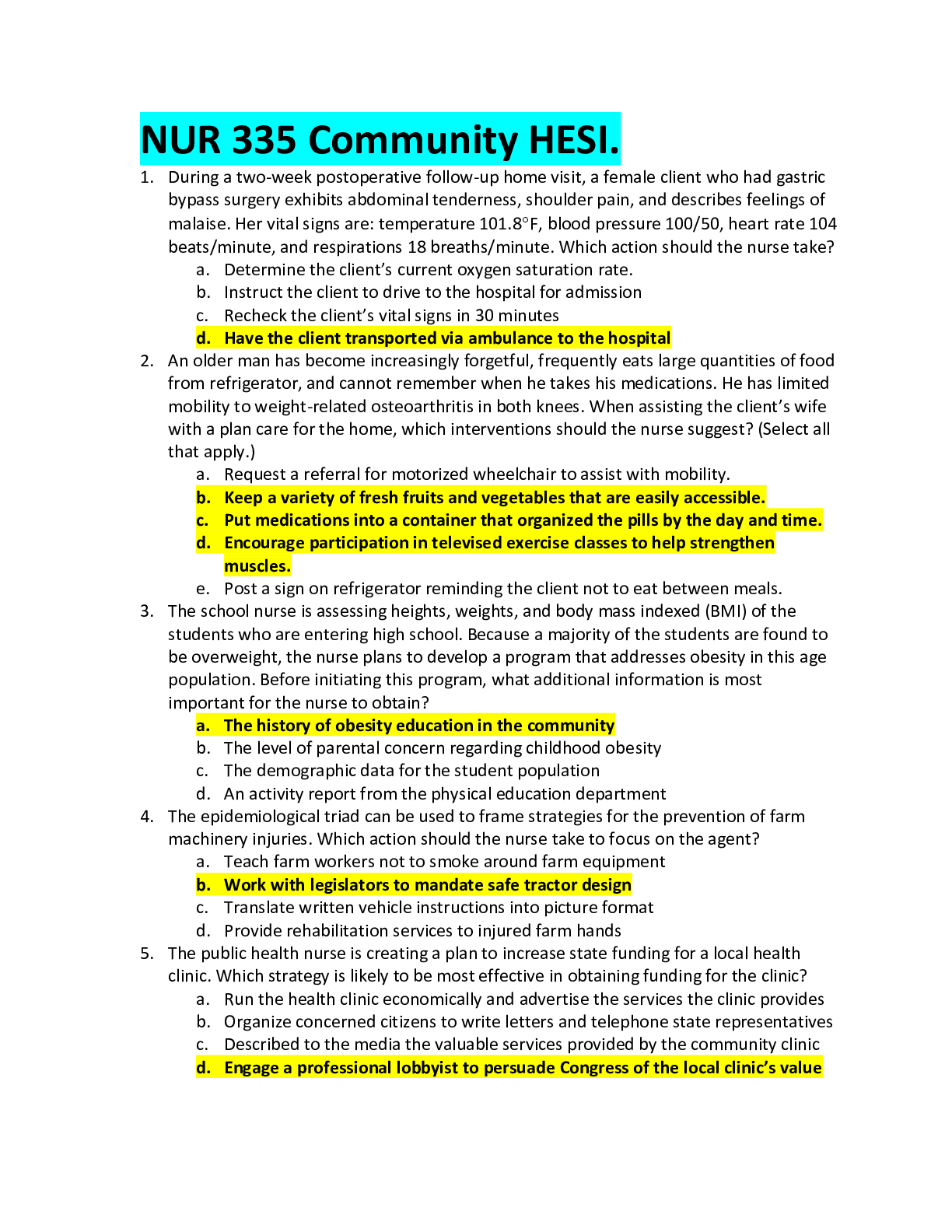ANATOMY BSC2347 Midterm Exam (1) |A&P II Midterm, 100% score
Document Content and Description Below
ANATOMY BSC2347 A&P II Midterm • Question 1 Which type of plasma protein plays a role within maintaining plasma osmotic pressure, blood pressure and is the most numerous? • Qu... estion 2 Which term best describes the amount of air expelled from the lungs after a maximum inspiratory effort? • Question 3 As the inspiratory muscles contract, the thoracic volume increases leading to an increase of pulmonary volume, which increases the intrapulmonary pressure. • Question 4 Which portion of the EKG wave pertains to the atria undergoing depolarization? • Question 5 The right atrium: • Question 6 Which of the following is true of the pleura of the lungs? • Question 7 The visceral pleura is found attached to the inner surface of the thoracic cavity. • Question 8 Which portion of the cardiac conduction system controls the rate at which the heart contracts? • Question 9 The pulmonary arteries contain deoxygenated blood. • Question 10 Which statement about the lungs and bronchi is true? • Question 11 Which of the following is true of thrombocytopenia? • Question 12 For expiration to occur, the intrapulmonary pressure has to: • Question 13 Which muscle is not considered a respiratory muscle? • Question 14 Which of the following is the most numerous type of leukocyte? • Question 15 • Question 16 The right atrium and right ventricle will contract first, then the left atrium and ventricle contract. • Question 17 Which of the following is NOT true regarding inflammation? • Question 18 Type O blood is the universal recipient blood type. • Question 19 Cardiac output is the amount of blood ejected from both ventricles with each contraction. • Question 20 Which factor will NOT directly affect stroke volume? • Question 21 What statement is true of capillaries? • Question 22 The left ventricle: • Question 23 Which of the following is true of erythrocytes? • Question 24 The exposure rate of a pathogen determines the effectiveness of innate defenses. • Question 25 Which of the following is true of polycythemia? • Question 26 Stroke volume is the measure of: • Question 27 Which of the following is true of the trachea? • Question 28 Which of the following is NOT a benefit to the inflammatory process? • Question 29 What is true of gas exchange within the lungs? • Question 30 Humoral immunity involves the production of antibodies that will attack any bacteria or virus. • Question 31 Anemia is classified and defined as the body being iron deficient. • Question 32 The trachealis muscle is located on the posterior aspect of the trachea, facing the esophagus. • Question 33 Antibodies are specific to one type of epitope. • Question 34 The bronchial tree allows for passage of air and gasses to reach the alveolar sacs where gas exchange occurs. • Question 35 Which of the following is a role of the nasal cavity? • Question 36 Which of the following choices is the correct pathway of the cardiac conduction system? • Question 37 An abnormal clot formation within a blood vessel is referred to as: • Question 38 Which term best describes the normal amount of air that is brought into and out of the lungs during quiet or resting breathing? • Question 39 Which portion of the EKG wave pertains ventricles contracting during the cardiac cycle? • Question 40 For inspiration to occur, intrapulmonary pressure must be higher than atmospheric pressure? • Question 41 The pharynx assists in moistening and humidifying inhaled air? • Question 42 Which of the following is true of veins? • Question 43 T Helper cells are involved in cellular and humoral immunity activation. • Question 44 What is secreted by the alveoli cells that prevent the lungs from collapsing between each breath by reducing surface tension? • Question 45 Arterioles are the smallest form of an artery and is where gas exchange occurs. • Question 46 Which of the following is true of cellular immunity? • Question 47 Which of the following is true of the intercalated discs? • Question 48 Which anatomical structure ensures the heart valves only open and close in one direction? • Question 49 Cardiac output is measured by multiplying heart rate (per minute) by breathing rate (per minute). • Question 50 The thoracic and pulmonary volumes both have the ability to increase. [Show More]
Last updated: 2 years ago
Preview 1 out of 6 pages

Buy this document to get the full access instantly
Instant Download Access after purchase
Buy NowInstant download
We Accept:

Reviews( 0 )
$12.00
Can't find what you want? Try our AI powered Search
Document information
Connected school, study & course
About the document
Uploaded On
Aug 10, 2020
Number of pages
6
Written in
Additional information
This document has been written for:
Uploaded
Aug 10, 2020
Downloads
0
Views
59














